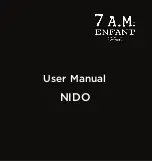
5
Fig.c
Fig.d
Fig.b
Altitude
adjustment
Azimuth
adjustment
EQ-6
The EQ6 mount has controls for both
conventional altitude (up-down) and azimuthal
(left-right) directions of motion. Use the altitude
adjustment T-bolts for altitude adjustments.
These allow fine-adjustment for setting the
mount to your local latitude. The azimuthal axis
is changed by the two azimuth adjustment
knobs located near the tripod head. These allow
fine-adjustment of azimuth for polar aligning
(Fig.b).
R.A. adjustment
Dec. adjustment
Warning
Tips
Trouble Shooting
Do not adjust the mount manually when
under the EQ6 SkyScan
TM
operation mode.
The telescope will have to be returned to
the Home Position and initial star alignment
will have to be done again. (See Initial
Setup under Hand Control Operation for
information on the telescope Home
Position. )
Make sure to loosen one altitude
adjustment T-bolt before tightening the
other. Over-tightening can cause the bolts
to bend or break.
Power
DC 12V
Dec. scale
R.A. scale
Latitude
scale
Power
DC 12V
In addition, this mount has direction controls for
polar aligned astronomical observing. These
directions use right ascension (east/west) and
declination (north/south) axis. There are two
options to move the telescope in these
directions: For large and quick movement,
loosen the R.A. lock level under the R.A. shaft
or the Dec. lock level near the top of the mount
(Fig.c). For fine adjustments, use the EQ6
SkyScan
TM
hand control (see "Hand Control
Operation").
There are three numerical scales on this mount.
The lower scale is used for polar alignment of
the telescope to your local latitude. The R.A.
(right ascension) scale is measures hour angle
and is adjustable to your local meridian. The
declination scale is located near the top of the
mount (Fig.d).
ON
OFF
ON
OFF
Summary of Contents for EQ6
Page 24: ...VI...





































